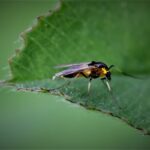Ever had a plant die for reasons you can’t explain? This could be aphid damage. Aphids are little insects that feed on plants. Often, they are one of the peskiest pests that can come across your garden.

It’s very common to not even recognize aphid damage to plants and can lead to many unresolved plant issues.
Moreover, aphids are so tiny they are usually very hard to get rid of through manual means. Aphids can multiply rapidly fast, carry plant viruses, and suck nutrients from plants.
Aphids are very hard to get rid of without having a structure in place to stop them permanently. Aphids cause serious fiscal loss in business such as plant nurseries and garden centers.
Aphids are particularly popular in temperate regions but are distributed across the globe. Interestingly, Aphids have been able to keep a stable population on Earth for millions and millions of years thanks to their reproductive systems.
It’s likely they evolved from other adelgids and phylloxera in the Early Permian Period, which is around 280 million years ago – this means that aphids are older than some varieties of plants.
For a pest that has been around for this long, there certainly isn’t an easy way to get rid of them or to solve the situation with a cure all. To get rid of aphids you have to detect them early and have a foolproof plan to stop them feeding.
We will explain how to identify aphid damage as well as some ways you can attempt to quell the damage to your plants.
Identifying Aphid Damage
Identifying if you have aphids by simply looking at your plant won’t work. Aphids are incredibly small and nearly invisible to the naked eye, even when in their most mature state an Aphid can reach maybe a ¼ of an inch in size.
With a microscope, aphids have soft, often wooly or waxy bodies that can be green or black or even colorless. They have two antennas above each eye. They use a sucking mouthpart called a stylet to suck sap from plants.
With a microscope, most aphids can be identified through two short tubes which extend from their hind end called cornicles.
Often, an aphid’s morphology and anatomy can completely change as the season goes on. For instance, when a plant has had its nutrients sucked out of it, an aphid can produce winged offspring that will travel to other plants for nutrients.
It is easier to identify an aphid infestation by the damage caused to the plants rather than trying to identify the insect themselves.
These are common signs of Aphid Damage on plants:
- Look for misshapen yellow leaves. As their nutrients have been sucked out the leaves can go yellow.
- If the plant is covered in a sticky substance. This is a clear sign that aphids have been feeding on the plant. They suck the sap from the plant which contains the nutrients, and release a waste product known as ‘honeydew’ while feeding. Not only is this sticky substance a sign of aphids but it can also attract other insects such as ants which often work in tandem once aphids have left a plant.
- This honeydew can cause a mold known as sooty mold. This mold can be black in color and while signs of other things, can be a symptom of aphid damage.
- If there are many visible insects feeding on your plant, that don’t regularly feed on plants, such as a ladybird, then this could be the sign of an aphid. These insects will likely be feeding on the aphids.
- Aphids transmit plant viruses too so if your other plants have a virus that has been transmitted to another this could be aphids.
Controlling Aphid Damage

Getting rid of aphids is an issue that has plagued farmers and horticulturists for millenia. Aphids are a-sexual so reproduce at a seriously alarming rate. Moreover, as previously mentioned, they have managed to maintain a really strong population for over 200 million years.
They are also distributed across the world but enjoy temperate climates the most. So, your best choice is to opt for control and prevention rather than eradication.
Short Term Solutions:
- Cold Water: Sometimes if you have a large infestation, a blast of very cold water can dislodge and confuse the aphids. Aphids rarely return to the same plant.
- Similarly, hosing your plants down regularly can help reduce an aphid population for the same reasons as the previous solution.
- Flour Dusting: Dusting a plant with flour can send the aphids away as they get confused but the flour can also affect them physically causing them not to return.
- Oils can be purchased as well as sprays specifically for aphids that can help get rid of them. Aphids are mostly resistant to general insecticides. Here is an aphid spray.
Long Term Solutions:
- Utilise predatory insects. Insects such as ladybugs, as well as others, prey on aphids. If you can increase the amount of these insects in your garden through other means then your aphid population will decrease.
- Similarly, many birds eat aphids too. Many farmers find that chickens will eat aphids and other insects when allowed to roam in a planting area.
- Grow companion plants that will keep your aphids at bay. For example, garlic and chives can repel aphids. Catnip or ‘Nepeta’ as it is known botanically, can also ward off aphids.
- Conversely, you can ‘trap’ aphids by planting stuff you know they like more than the plants you want to keep them from eating. Aphids love mustard and nasturtium.
Final Thoughts
There you have it. Aphids themselves are pretty invisible to the human eye, only when they swarm can we see them on plants. It’s always better to choose to identify an aphid infestation through damage caused rather than by actually picking out the insect.
Aphids, once identified, are super hard to get rid of. Their a-sexual reproduction has kept their population high for millennia. Long term plans are often the best to keep aphids away and usually require a combination of different solutions to get the best results.
- Best Hanging Plant For Low Light - September 4, 2023
- Best Indoor Plants Florida - August 28, 2023
- Best Plants For Bathroom Smells - August 21, 2023








